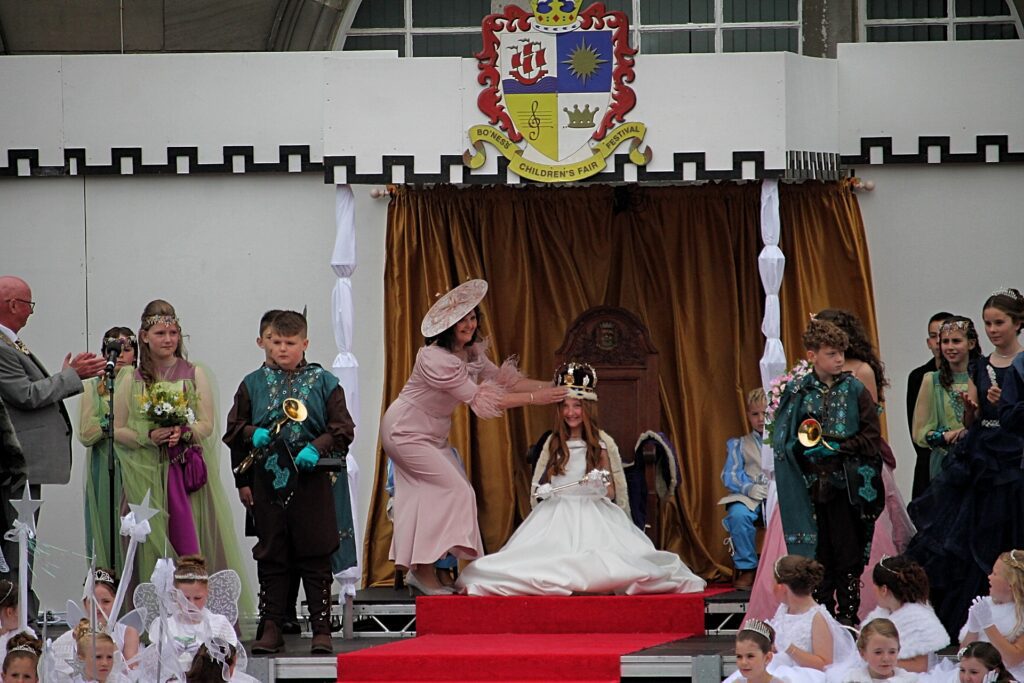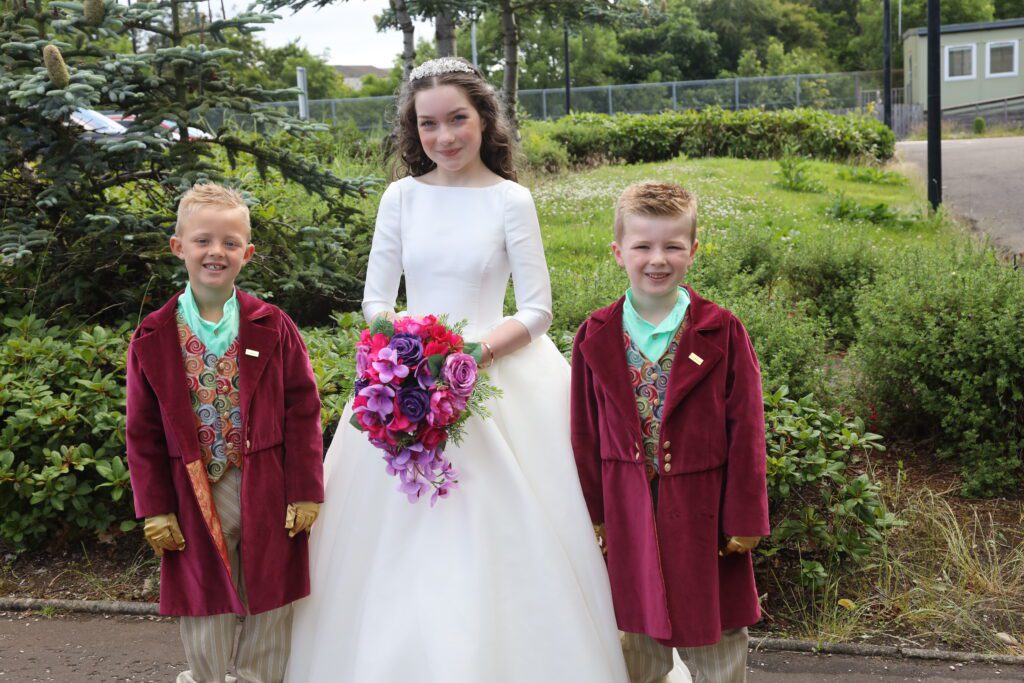They say that first impressions count. Both good and bad. But to start to understand what makes a place tick takes a long time – and in the case of a complex place like Bo’ness, a very long time. Unless, that is, there is something which captures the essence of the place and gives an instant picture of how and why it has evolved.
That’s how I see Bo’ness Fair Day. It captures imagination, enthusiasm and emotion in its magical blen of pageant, song, dance and occasion.
Once, many towns all over the British Isles held similar regular celebrations. Why is it that the Bo’ness Fair has not only continued, but has grown into the premier Children’s Fair? Why is it that over the years Bo’nessians have sunk so much pride and energy into the Fair?
HARD TIMES
Perhaps it was because smoke and fumes from salt-pans, bone works and foundries blackened stone and lungs alike. Or was it the dangers of whaling in icy northern waters? Or the poisoning of pottery workers using lead glazes? It may have been because of harsh conditions in the pits, which, of course, continued long after children had been banned from working underground.
Was Bo’ness Fair a one-day escape from such a life? Looking at its foundations, there’s plenty of evidence to support the need for joy and celebration. We can trace the start back to when miners and salt-workers were first freed from what was virtual slavery. Until the final legal loopholes were closed in 1799, most Bo’nessians were bound to the places where they worked, and were even sold with the pits or saltpans. Imagine the elation to be freed from such serfdom – ( even if the wages went down). There would be singing and dancing in Bo’ness, and, when working conditions began to improve at the end of the last century, the Fair evolved into the children’s pageant we share today, with its emphasis on youth and vitality.
When times were tough, Bo’ness did not put its head into the sand ( or the glaur ), but channelled its energies into the future. It looked to the future without forgetting what the past had to say. And, in 1986, if we can but listen, the history of Bo’ness and its people still has important messages for us.
LEARNING FROM THE PAST
But before you turn off because, as Henry Ford said, ” History is bunk”, let’s explain that history isn’t just about some strange events which happened thousands of miles away. History is about people. Ordinary people like you and me. And Bo’ness is brimming over with stories of those people who have left their marks on the town and its surroundings.
You can find the shell middens left by Stone Age folks over three thousand years ago, and there are dozens of Bronze Age burial sites. More people know a little about the Romans in Bo’ness, even if we don’t know whether the wall ended at Carriden or Bridgeness. But did you know there are sites of ten Roman forts or camps in and around Bo’ness, as well as the Wall and road?
Then there were the monks who came here to work the coal, and coal owners and colliers who came afterwards. There were thousands of other craftsmen and traders who contributed to the town – the iron foundries, engineers, seamen and merchants being just a few of the makers of Bo’ness without whom the community could not have thrived. Whilst each has made his mark in Bo’ness in a different way, each had a spirit of enterprise, despite, ( or because of ) the tough conditions. They probably had another thing in common : vision.
KINNEIL’S INVENTOR
One such visionary was born exactly 250 years ago, though not in Bo’ness. James Watt spent five years experimenting with the principles of the steam engine before he came to Bo’ness in 1768, ready to build his first prototype, financed by Dr John Roebuck of Kinneil House. Watt set to work secretly building this first steam engine with parts cast for him at the Carron Ironworks belonging to Roebuck & Cadell. The engine was used with success to pump water from Roebuck’s pits at Kinneil, and Watt was in the process of improving it when financial difficulties overtook Roebuck. He had already invested the huge sum of £30,000 in his Bo’ness salt works and collieries, but harsh economic times in Scotland brought about his bankruptcy. Roebuck’s share in the Watt engine was taken over by one of his creditors, Matthew Boulton, and the manufacture and sale of the engine was transferred to Birmingham.
What would have been the story of Bo’ness if Watt and Roebuck had been able to continue their partnership here at Kinneil?
Both Watt and Roebuck were able to package local resources and use them effectively. Iron and coal, skilled labour and capital. The end product was giant stride in the Industrial Revolution – even if Bo’ness didn’t see all the direct benefits. ( Three early Watt engines saw service in the Bo’ness pits, and the cylinder from that at the School Yard Pit was given to the town and can be seen outside Watt’s cottage by Kinneil House.)
THE SPIRIT OF BO’NESS
The history of Bo’ness is littered with people of energy and enterprise, who have done great things at home and abroad. That same spirit must be encouraged in Bo’ness today. The Heritage Area development is just one initiative which can benefit the town by encouraging visitors, and, at the same time, exploring in an exciting and entertaining way why Bo’ness has been significant locally, nationally and even internationally.
The Heritage Trust’s programme of development at Bo’ness will last for a number of years, eventually offering a linked series of sites where visitors will be encouraged to find out about the past in a stimulating way.
A great deal of emphasis will be placed on providing an exciting environment for the young, and already many teachers can see the potential of this new educational resource. Publications on the history of the area will be produced, and special events encouraged – all aimed at creating a living, working, exciting place in which to rediscover the past and look to the future.
And there are many other ideas which organisations and individuals have, all concerned with their vision of a better Bo’ness. They deserve our active support and involvement throughout the year.
TIME TO CELEBRATE
When the last echoes of ” Our Festal day ” have died, and the last arches have been dismantled, then it’s time to take stock and see other things that Bo’ness has to celebrate.
Pause a while after the Fair, and look around you. The heritage of Bo’ness is engrained in every stone and tree, in every place name and building. How will future generations be able to measure what YOU have done for Bo’ness? When the youngest fairies or flower girls of this year’s Fair come along with their own children to watch the Fair in the twenty-first century, what will they see?
WHO CARES FOR BO’NESS
It is not the exclusive right of politicians or public authorities to improve the town. They have certainly done their part over the years, and it is to be hoped that they will continue to invest in the future of the town. Having a vision of a better Bo’ness is something we can all share.
Caring for Bo’ness is everyone’s job. You could argue that the town is old enough to look after itself, but I don’t agree. Presenting a better Bo’ness can benefit all of us, young or old, working or not. Improve Bo’ness further, and it will be a nicer place to live. It will be an interesting and entertaining place to visit. But it will also be a better place in which to earn a living or to find work.
If we can build on the pride and confidence which we can see all around us on the Fair Day, the town becomes more attractive for business. Not huge, multinational companies, some of which come with great blaze of publicity, great promises – and all too often disappear to other parts of the world when it suits them best.
No, not massive concerns, but the sort of firms which we already see in Bo’ness. Only more of them, and a wider range of shops. More business will improve everyone’s prospects, not only now but into the next century.
START RIGHT NOW!!!
So the message is clear – if we are to thrive, we can all do our part. From a coat of paint on the door, to the window box of flowers; using the litter bins and looking after property; a new shop sign or an idea for tidying up a corner – being proud of Bo’ness and promoting the town.
When that magic which is the Fair is at its most heady and you’re proud to be in Bo’ness, when your heart beats faster and a lump comes into your throat – that’s when we can start to create the place we want. A better Bo’ness. For everyone. And we start right now!
BILL BREAKELL Director, Bo’ness Heritage Trust






